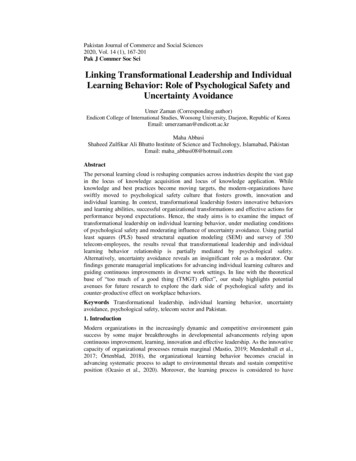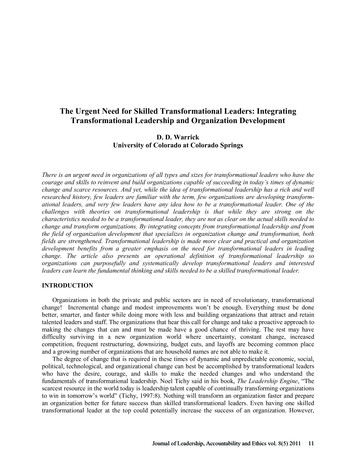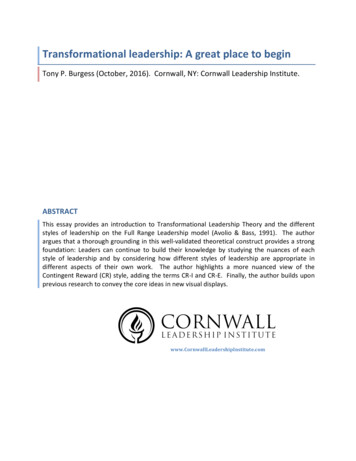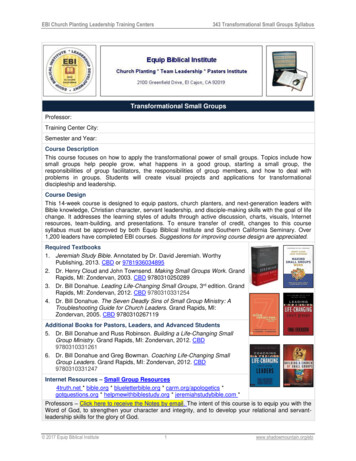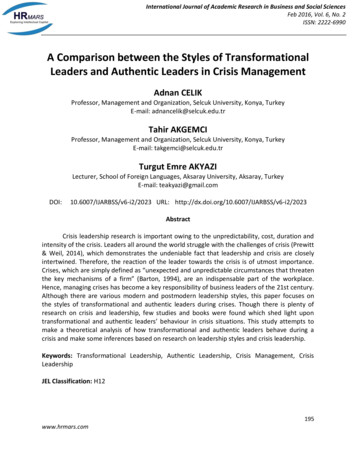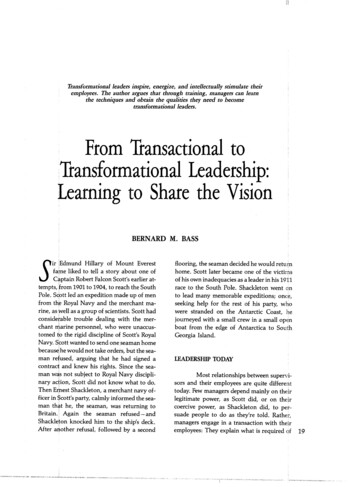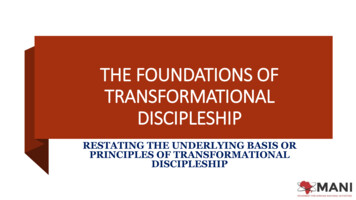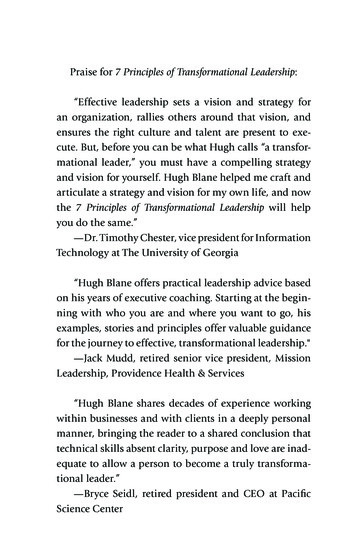
Transcription
Praise for 7 Principles of Transformational Leadership:“Effective leadership sets a vision and strategy foran organization, rallies others around that vision, andensures the right culture and talent are present to execute. But, before you can be what Hugh calls “a transformational leader,” you must have a compelling strategyand vision for yourself. Hugh Blane helped me craft andarticulate a strategy and vision for my own life, and nowthe 7 Principles of Transformational Leadership will helpyou do the same.”—Dr. Timothy Chester, vice president for InformationTechnology at The University of Georgia“Hugh Blane offers practical leadership advice basedon his years of executive coaching. Starting at the beginning with who you are and where you want to go, hisexamples, stories and principles offer valuable guidancefor the journey to effective, transformational leadership."—Jack Mudd, retired senior vice president, MissionLeadership, Providence Health & Services“Hugh Blane shares decades of experience workingwithin businesses and with clients in a deeply personalmanner, bringing the reader to a shared conclusion thattechnical skills absent clarity, purpose and love are inadequate to allow a person to become a truly transformational leader.”—Bryce Seidl, retired president and CEO at PacificScience Center
“If you haven't read this book you are more lost thanyou realize! Far too many of us spend far too much timestuck on the hamster wheel of the day to day. Stuck withno direction and too much to do. But in this insightfulbook Hugh Blane gives us a clear road map of how to getoff the hamster wheel and out of the fog by latching ontoand then maintaining laser focus on our PURPOSE!!!Only apply these principals if you want a life far morefulfilling and if you want to close the gap between whereyou are today and where you aspire to be tomorrow!”—John Felkins, director of coaching, Dave Ramsey“Leadership is a choice we make, it’s not just a roleor a title. Being a transformational leader is both a privilege and a responsibility. Hugh Blane’s 7 Principles ofTransformational Leadership outlines a paradigm and aframework on how anyone can be a transformationalleader by choice.”—Deepak Goindwani, vice president, product development at CDK Global
7PRINCIPLES OFTRANSFORMATIONALLEADERSHIPCREATE A MINDSET OF PASSION,INNOVATION, AND GROWTHHUGH BLANE
Copyright 2017 by Hugh BlaineAll rights reserved under the Pan-American andInternational Copyright Conventions. This book maynot be reproduced, in whole or in part, in any form orby any means electronic or mechanical, including photocopying, recording, or by any information storage andretrieval system now known or hereafter invented, without written permission from the publisher, The CareerPress.7 Principles of Transformational LeadershipTypeset by PerfecType, Nashville, Tenn.Cover design by Jonathan Bush DesignPrinted in the U.S.A.To order this title, please call toll-free1-800-CAREER-1 (NJ and Canada: 201-848-0310) toorder using VISA or MasterCard, or for further information on books from Career Press.The Career Press, Inc.12 Parish DriveWayne, NJ 07470www.careerpress.comLibrary of Congress Cataloging-in-Publication DataCIP Data Available Upon Request.
AC K NOW L E DG M E N T SThe acknowledgment section of a book is not writtenfor the reader. It is for the author to thank the peoplewho helped him or her on the journey of writing a book.Indulge me as I thank a group of very special people.First and foremost I want to say thank you to my parents. Both were courageous souls who chose to immigrate with two small children from Scotland to Canadaand then Birmingham, Alabama, in 1968. Were it not fortheir desire for a better life, for themselves and primarilyfor their children, this book would not be in your hands.Both would be exceptionally proud of this accomplishment, as I am of theirs.I want to thank my mentor and business advisor AlanWeiss. Alan has stretched my thinking and, by doingso, enriched my life in ways I never imagined possible.Thank you, Alan, for showing me how to live boldly,confidently, and generously. And yes, the second bookis on its way.
To the clients who partnered with me to convert theirhuman potential into accelerated results I cannot thankyou enough. You gave me the opportunity to bring theinsights of transformational leadership into your all-toooften overwhelmed, overscheduled, and overbookedworkplace and to make a difference in your performancewhile also enabling human flourishing. I am enriched byyour partnership and thank you.I want to thank the business colleagues who positively shaped my thinking with the book. A heartfeltthank you goes out to Roberta Matuson, Linda Popky,Mark Rodgers, Judy Chan, and Richard Citrin. Each ofyou inspired me to become an author and to get out ofmy own way with my writing. I am honored to join youas published authors and indebted to you for your support and encouragement.Thank you to my sister, Elise, who sees the very bestin me and knew I had a book to write even when I didn’t.Your belief in me is without question a gift that I cherish and relied heavily upon while writing the book. Tomy best man, Robert, your wisdom, faith, and discernment have shaped me in powerful ways. Your thoughtsand perspectives are on many pages of this book, andno, you cannot have a portion of the royalties. To mybrother from another mother, John Felkins. We becamefast friends and your friendship and encouragementhave been ballast when I’ve felt as though I was sinkingamidst the responsibilities of work and business. You are
a fabulous father and amazing advisor and I am blessedto call you my friend.Thank you to Adonis McNeal. You’ve been on thereceiving end of far too many calls during which Ithought out loud about each of the seven principles andended up on my soapbox. You were always gracious andgenerous with your attention and encouragement. Youtoo are my brother from another mother. It’s too bad Ididn’t get your dashing good looks though.And last, but certainly not least, to the love of mylife, Alyson Sharron. Without question, in front of everygood man stands a strong, powerful, and loving womanpulling him into the future. You are that for me. I thankyou for your swift kick in the pants, your swift voice ofencouragement, and the unquestioning admonition ofgreater possibility. Were it not for you this book wouldnever have happened. Thank you for your patience, love,and support.
CON T EN T SIntroduction: Mindset Is Not Just for Athletes,Academics, and Cave-Dwelling Mystics. . . . . . . . . . . . . 11Chapter One: The Purpose Principle. . . . . . . . . . . . . . . . . . 27Chapter Two: The Promises Principle . . . . . . . . . . . . . . . . 57Chapter Three: The Projects Principle . . . . . . . . . . . . . . . . 89Chapter Four: The Persuasion Principle. . . . . . . . . . . . . . 125Chapter Five: The Praising Principle . . . . . . . . . . . . . . . . 159Chapter Six: The Perseverance Principle. . . . . . . . . . . . . 191Chapter Seven: The Preparation Principle. . . . . . . . . . . . 219Conclusion. . . . . . . . . . . . . . . . . . . . . . . . . . . . . . . . . . . 249Index. . . . . . . . . . . . . . . . . . . . . . . . . . . . . . . . . . . . . . . . 253About the Author. . . . . . . . . . . . . . . . . . . . . . . . . . . . . . 256
I N T RODUC T ION:MINDSE T IS NOTJ US T FOR AT HL E T E S,A C A D E M I C S , A N D C AV E DW E L L I NG MY S T IC SUnderstand Your Mindset and You’ll Understand Your ResultsI did not come into this world with an “I can do anything”mindset. Far from it. At 48 years old, I found myselfunfulfilled emotionally, spiritually, and fi nancially—inspite of being in the third year of a marriage to the love ofmy life. I had been working my tail off to be successful,but felt as though I was driving with one foot jammedon the accelerator and the other squarely on the brakes.I was exerting a massive amount of energy each day, butgoing nowhere fast. Every day I felt like Sisyphus climbing a mountain—only to be rolled back down to the11
7 Principles of Transformational Leadershipbottom and admonished for daring to climb the mountain. Living this way was exhausting.In hindsight, my mindset was rooted in scarcity andpoverty. No matter what I accomplished, it wasn’t goodenough. My favorite reply to people giving me compliments and acknowledging me for what I was accomplishing was, “Yes, but. . . .” I summarily dismissed peoplebecause I didn’t believe what I was accomplishing wasup to the high standards I had set. My thinking was mybiggest enemy. How did I get here?On a day like any other for a 6 year old, I was playingin my bedroom when I heard my mother screaming. Iran downstairs and saw her blocking the doorway to ourhouse and three men standing on our front steps. I ranand stood in the cradle of my mother’s arm and lookedat the men with fear and confusion. They were not policeofficers delivering bad news about my father, nor werethey thugs there to rob us. They were just men doingtheir job, which on that day was to repossess our furniture. And doing their job left my mother screaming andfrantically telephoning my father to “Take care of this!”During a recession in the 1960s in Scotland, repossessing furniture happened to other families, not to mymother. Christobel Rice Blane had married into one ofthe wealthiest families in Glasgow, Scotland. Life wasexactly as she hoped until my grandfather died. Mygrandfather, David Blane, was an extraordinarily giftedbusinessman who started his business life pushing alarge wooden cart up and down the streets of Glasgow,12
Introductionoffering bread, fruit, fish, and any other product he couldsell for a profit. He worked long, hard days and had an “Iwill do this” mindset.In the time span of 40 years, my grandfather amasseda fortune. He had a Jaguar, MG, and Rolls Royce dealership, a scrap metal business, and a bookie joint. Heraised his 10 children with silver spoons in their mouthsand with the support of two nannies. The family homewas built and named for a vacation property my grandfather found in Padua, Italy, and had not one, but two,billiard rooms. At one point, my father’s clothes werecustom tailored and he drove one of the nicest cars intown. My father was the proverbial “big guy on campus.”My mother came from the opposite side of the tracks.Her father was a laborer, who at one time worked in acoal mine. Their family had no money. When my motherwas in high school, she had one dress she would wearto school every day. She would come home and iron itto wear again the following day. Cristobel knew she waspoor and the thought that kept her motivated was thehope of “getting out of this godforsaken place” and making a better life for herself.On one hand, the mindset with which my father wasraised was one of affluence and privilege. My mother’smindset, on the other hand, was one of poverty and scarcity. What happened on the day the repo men arrivedgalvanized my mother’s mindset and obliterated that ofmy father. For my mother, the highest hopes she had forher life came crashing down around her. For my father,13
7 Principles of Transformational Leadershipany sense of self-worth or self-esteem shriveled like a raisin in the sun.What does this have to do with me and my mindset?On that fateful day, my mindset as a 6 year old shiftedfrom safety and security to fear and uncertainty. I cameto believe that whatever possessions I had could andwould be taken away from me. This mindset permeatedmy thinking; my perceptions of people, places, and leadership placed me squarely on track for the life I foundmyself living at 48 years old.My intent in recounting this story is to provide youwith context about how mindsets and the leadership youand I exhibit are the byproduct of nature as well as nurture. The only real choice we have is to acknowledge ourcurrent mindset, accept our role in creating or toleratingit, articulate the desired mindset we want to have, andthen take action each day to create it.I’ve found that 80 percent of a leader’s success is mental. There are leaders who believe that work is a long,slow slog through enemy territory on their belly withbullets flying over their heads. This mindset will producelower performance 100 percent of the time. You cannotperform at the highest levels if your mindset is equallynot at the highest level.Although neuroscience and psychology have positively shaped my mindset, they are not the cornerstonesof this book. I am not a psychologist, but rather a leadership expert who has successfully changed my own mindset, as well as the mindsets of my clients, for the better.14
IntroductionI wrote this book for two key reasons: First, in theworld of work, the amount of untapped human potential inside organizations is staggering. After working in 43states and seven countries on three continents, I’ve witnessed firsthand 65 percent of employees with a chroniccase of JDTM: just doing the minimum. Their mindsets arecharacterized as exerting the minimum amount of effortpossible while maintaining a positive annual review. Butbefore you conclude that employees with JDTM are greedy,lazy, and selfish, consider the fact that leaders in corporations across all industries suffer from JDTM also and arethe carriers of the JDTM virus. Far too often, the mission,vision, and values guiding organizations, teams, and individual employees are written by senior leaders while onexecutive retreats in mountain lodges. They are, in turn,devoid of any tangible connection with the people whomeet and engage the customer on a daily basis. Employeessuffer from JDTM because their leaders are unwilling toundertake the individual transformations required inorder to transform their teams or organizations.Second, on a personal level, I hope to enable morehuman flourishing. I believe in the biblical passage thatreads, “And to whomsoever much is given, of him shallmuch be required.” I have an obligation and responsibility to take what I’ve learned and pass it along to otherswho can benefit. We will cover this in extended detail inthe following chapters.Before moving on, I have an assessment you’ll want tocomplete. These are not ethereal, navel-gazing questions15
7 Principles of Transformational Leadershipthat require you to sit on a cushion in a cross-legged position for 60 minutes. They are statements that, when considered thoughtfully and purposefully, will help you seethe connection between your mindset and your results.The Transformational Leadership AssessmentOn a scale from 1 to 10 (1 is strongly disagree and 10 isstrongly agree), rate yourself on the following statements:1. I have a clearly articulated purpose for myleadership and personal life.2. I have clearly defined the priorities that arein service of my purpose, as well as the people who matter most to me.3. I have made non-negotiable promises to allof the people who matter most to me bothpersonally and professionally.4. I know with certainty and have articulatedthe behaviors I will exhibit in order to achievemy purpose, promises, and priorities.5. I actively stretch my leadership every yearwith new projects that provide increasedvalue to the people who matter most to me.6. I have a remarkable ability to persevere inthe face of adversity and setbacks.7. I actively teach and mentor others in orderto cement my learning, as well as to helpothers grow and learn.16
Introduction8. When it comes to my thinking, I “play towin” as opposed to “play not to lose.”9. I have cultivated a positive mindset, as wellas positive self-talk.10. I have a contagious and persuasive beliefabout helping others grow their leadershipand enhance their mindset.11. I praise myself for things I do well and eliminate or reduce the things I don’t do welldaily, weekly, and monthly.12. I take time to reflect and think creativelyand strategically about my professional andpersonal life.After completing the Transformational LeadershipAssessment, consider the following questions: What statements received the highest andlowest scores?What are the implications for these areasbeing rated so high and low?If you could significantly improve oneanswer, which one would have the biggestpositive impact on your leadership and yourresult?A Mindset of Growth, Optimism, and PositivityHere’s what I’ve learned working with organizationssuch as Sony Pictures, Boeing, Nordstrom, Starbucks,17
7 Principles of Transformational Leadershipand Microsoft: Transformational leaders are dissatisfiedwith being good, and instead believe in and strive for astate best described as “flourishing.” In this chapter, Istart by presenting a new mindset about rethinking theworld of work and position you for transformationalgrowth.If you want a flourishing business—a business thathas top-line growth, greater profitability, high levels ofcustomer satisfaction, and top talent retention—youmust have flourishing relationships with your employees. In today’s world of work, the customer experiencemust be so compelling that customers would not consider going elsewhere. That can only be created by committed and happy employees.When leaders commit to creating experiences thatare compelling, noteworthy, and loyalty-centric, theonly way to execute and deliver this strategy is throughhappy and satisfied employees. In no uncertain terms, ifyou want to create a compelling, flourishing experiencefor your customers but your employees are not flourishing, there is just no way for your business to flourish. Thefollowing is an equation that will transform your leadership and your results:FB (FE FC ME)A flourishing business (FB) comes from flourishingemployees (FE), flourishing customers (FC), and memorable experiences (ME).18
IntroductionFlourishing employees are created by flourishingleaders who commit to cultivating flourishing customersand producing memorable experiences. And yet, thereare employees who should never be placed in customerfacing roles but find themselves there on a regular basis.Some of these people are so uncomfortable, incompetent,or indifferent to the customer that they should never beput in roles that require customer interactions.Are there examples inside your organization inwhich unhappy employees are creating negative experiences for customers? Are there times when employeessee a customer as an interruption and something to betolerated, as opposed to a precious asset that needs tobe cultivated and treated with respect? Is it ever acceptable in your employees’ eyes to be rude and uncaring? Ifyou answer yes, the problem doesn’t rest with the frontline employee. The bigger question is: Do leaders walkthrough your doors each morning with a keen desire tomake a meaningful difference in your customers’ andemployees’ lives?If you as a leader have lost this desire and are unableto feel enthused about making a difference in your mostimportant constituents’ life, it is time to make an exitfrom the ranks of leadership. It is really quite simple. Ifyou are not flourishing at work, it is time for a change—first in mindset and then in role, if need be. Your level ofpersonal flourishing permeates and shapes your leadership and shows up in the customer experience.19
7 Principles of Transformational LeadershipIt’s Not What Others Tell You; It’s What You Tell YourselfThe number-one lament of readers of my blog is thatthey feel overwhelmed and don’t have the time necessaryto effectively lead. This feeling can happen for a varietyof reasons, some of which are valid, whereas others arerooted in the leader’s mindset. Throughout the last 25years, I’ve found six factors that contribute to the feelingof overwhelm—all of which create a mindset that lowersperformance and stifles the well-being of customers andemployees.1. Underperformance is tolerated. Every organization has employees that underperformand others that over perform. The formerare interested in having a paycheck and havelittle enthusiasm for increasing their performance. Rather than find a job at which theexpectations are lower, they’re allowed to stayin their roles even in the face of underperformance. When underperformance is tolerated,a clear message is sent to all employees thatthis is acceptable and there are no repercussions. This mindset stalls growth and is a catalyst for even greater underperformance.2. Miscommunication. When leaders feel overwhelmed and are continually running fromone meeting to another without any margin or white space, miscommunication is20
Introductionassured. By that I mean you will miss thesubtle nuances of interpersonal communication, and in the process of rushing frommeeting to meeting, miscommunicate expectations due to the anxiety of needing to be intwo places at once. This leads to false startsand the all-too-familiar rework required as aresult of miscommunication.3. Being tired, worn down, and burned out.In America, leaders pride themselves onpushing themselves to the limit. It is a badgeof honor to say to family and friends thatyou work 70 hours a week. And yet, in studyafter study, the research shows that as thenumber of hours you work each week goesup, the quality of your work goes down.Greater effectiveness comes from leaders andemployees who are energized, uplifted, andenthused about making a positive difference in the life of a customer. This is nearlyimpossible to do when a leader or employeeis hanging on for dear life and trying to keeptheir nose above water.4. Not having the skills to manage stresseffectively. There are two types of stress weface at one time or another: eustress and distress. Eustress occurs when the gap betweenwhat we want and what we have is slightly21
7 Principles of Transformational Leadershippushed, but not in ways that lead us to feeloverwhelmed. We see this stress as manageable and our goal achievable.Distress is the opposite. The gap is unmanageable and the goal is seen as unreachable.This leads us to feel overwhelmed, out of control, and ineffective. Leaders need the abilityto capitalize on eustress, as well as the ability to reduce or eliminate the causes and oreffects of distress. And yet the number-onestrategy for dealing with stress in organizations today is to put your nose to the grindstone and gut it out. There are times whenthis strategy is needed and the preferred wayforward. However, too often working harderis preferred by busy and overwhelmed leaders over working smarter.5. Poor time management and prioritysetting habits. The exigency of a leader’sday-to-day work is one in which continualpriority-setting is a necessity but not a reality.Being able to strategically and respectfullysay no to bosses as well as customers is a keyskill transformational leaders have mastered.When leaders look at their calendars and askwhat percent of their time is spent in lowvalue producing activities relative to theirmost strategic priorities, what figure wouldyou expect to hear? Eighty percent? Seventy?22
IntroductionFifty? All too often the figure from my coaching and consulting clients is 30 percent. Withgreater priority-setting skills, as well as goodtime management, a leader can increase thestrategic use of their calendar by 25 to 50 percent, which has a transformational impact ontheir performance.6. Unaware of the importance of mindset onperformance. In business schools acrossthe country, the number of classes taughton mindset and mental training is tiny. Yes,psychology is taught in broad and often theoretical terms, much like the tried-and-truecourses on financial management and marketing, and new courses on social media.What happens in between the ears ofleaders and employees is in many ways whatdetermines financial performance, marketshare, and talent acquisition and retention.When a factor as important as mindset ismissing from a leader’s arsenal of tools, theresults are less than appealing.When you look at this list, undoubtedly you willbe able to add other factors that lead you to feel overwhelmed. Just about all of these can be influenced bya leader. Happy employees are essential for happy customers. One of a leader’s primary jobs is to manage themindset of his or her employees so the mindset of the23
7 Principles of Transformational Leadershipcustomer is favorable and inclined to do more businesswith the organization.How employees talk to themselves is critical. Somemay feel that no matter how good an idea they create,management will never support them. If their belief andself-talk is rooted in defeatist language and beliefs, itis impossible to behave differently until what they tellthemselves changes.For example, Robert was a new coaching client in thehealthcare field. He told me, as many of my clients do,of the 70-plus hours he was working and the demandson his time. He lamented feeling overwhelmed and frustrated because his day was spent in reactive firefighting mode. Things had gotten so bad that his employeeshad even asked him to become less reactive and to helpthem do the same. When I asked who was in charge ofhis schedule and how he spent his day, his answer was aresolute “hospitals and patients.”Robert was right in one regard: His work was determined in many ways by the ravages of a career in healthcare, where a person’s life and well-being is influenced byhis or her caregivers. These professions are surroundedby “a decision must be made now circumstances.”But Robert also missed a crucial distinction.Although the external factors influencing his day werereal, his response to them was equally so. Robert wasnot in charge of what happened to him every day, buthe was certainly in charge of how he responded to whathappened to him. How Robert responded rested24
Introductionsquarely in the six inches separating his two ears. Itwasn’t his boss, his hospital, or his patients. Robert’smindset was in charge of the people, processes, and perspectives he brought to bear every day. Changing yourmindset so as to unleash your human potential is whatthis book is about.The good news is there are seven principles that willhelp you master your leadership mindset and convertyour human potential, as well as the potential in yourteam and organization, into accelerated performance.Each of the following chapters corresponds with a different principle.25
1The Purpose PrincipleThe One Idea, Dream, Hope, or AspirationAsk 10 people what they would do if they won the lottery and had the financial resources to no longer work,and you’ll hear ideas such as “start my own business”or “start a charity.” Throughout the last 11 years as afinancial advisor, I saw this type of wishful thinking.Whenever I met a new or prospective client I wouldask a simple, straightforward question: “What, to you,is important about money?” The number-one answerI heard was “security.” And on numerous occasions Iheard from female clients that they didn’t want to endup as a “bag lady.”What was interesting is that the people I was speaking to and meeting with were not financially insecure.They had resources, but still carried with them a poverty27
7 Principles of Transformational Leadershipmindset. One healthcare executive making more thanone million dollars per year was worried about havingenough money to retire.But, having security as a purpose puts a strangleholdon many of the ideas, hopes, and dreams for what ourlives can be. The hopes and dreams we have for our livesget pushed aside because of our prevailing mindset.Let’s be clear about the one primary benefit of clarifying your leadership purpose: The jumping-off pointfor greatness both individually and organizationally is aclear and compelling purpose. People at work or in yourpersonal life who have achieved something extraordinary or who live lives defined as “rewarding” and “uplifting” have a clear and compelling idea about what isimportant to them, why it is important, and what valuethey will achieve by working to accomplish it.One of my clients is a hospital CEO who definedher purpose as follows: “I want to create a culture whereevery single employee is engaged in creating the extraordinary in patient care and safety.” Her purpose translatesthree things that are important to her:1. Patient care and safety are paramount.2. Every employee must be engaged in order tomake this happen.3. Creating the extraordinary is essential.This CEO is not content with the ordinary. Shebelieves the extraordinary is possible and sees her job asprimarily focused on creating the cultural transformation28
The Purpose Principleto make this happen. Her purpose guides her every moveand permeates her thinking even in the constantly shifting market that is healthcare.When I asked her about our work together she said,“Getting clear about my purpose was not easy, but it hasmade leading so much easier and rewarding now that Ihave it.”That leaves me with these questions for you: Are youclear about your leadership purpose? Do you feel passionate about what you want? Are you relentless in learning and growing your own skill set as a leader as wellas your mindset, and creating value for others? Or doeseach day feel as though you are driving in fog?What does driving in fog look like from a leadershipperspective? Imagine you’re on vacation, driving to NapaValley wine country to taste some of America’s mostnotable wines. In the hopes of making your trip evenmore memorable you rent a high-performance convertible. It’s red, shiny, and a real head-turner. Just looking atthe car increases your heart rate and you can’t wait to hitthe open road.As you round a curve enjoying this wonderfulmoment, you suddenly drive head-on into a fog bank.Out of nowhere the fog encases your car. What is the firstthing you do? Most likely, you’ll put your foot on thebrakes to slow down. Next, you’ll put both hands on thewheel and possibly even pull yourself closer to the wheelin the hopes of seeing better. And to help even further,you’ll tur
“Leadership is a choice we make, it’s not just a role or a title. Being a transformational leader is both a priv-ilege and a responsibility. Hugh Blane’s 7 Principles of Transformational Leadership outlines a paradigm and a framework on how anyone can be a transformational leader b
